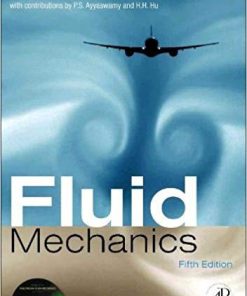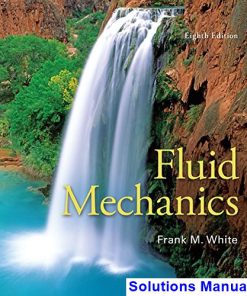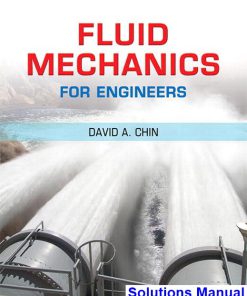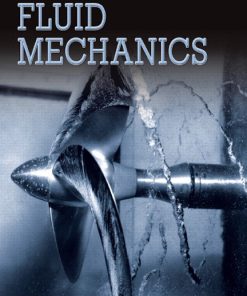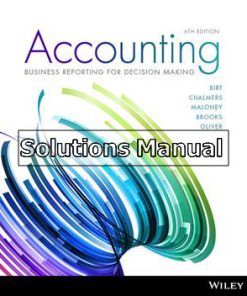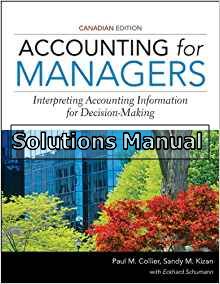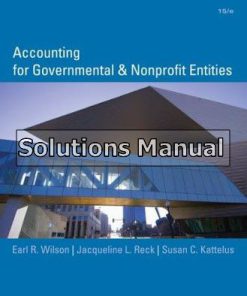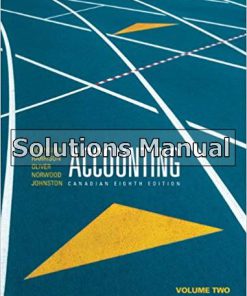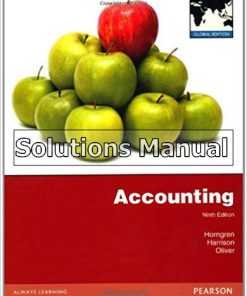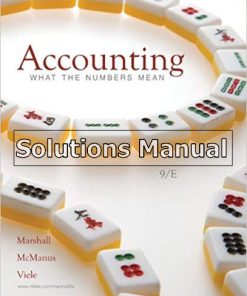Fluid Mechanics For Chemical Engineers With Microfluidics And CFD 2nd Edition Wilkes Solutions Manual
$26.50$50.00 (-47%)
Fluid Mechanics For Chemical Engineers With Microfluidics And CFD 2nd Edition Wilkes Solutions Manual.
You may also like
Fluid Mechanics For Chemical Engineers With Microfluidics And CFD 2nd Edition Wilkes Solutions Manual
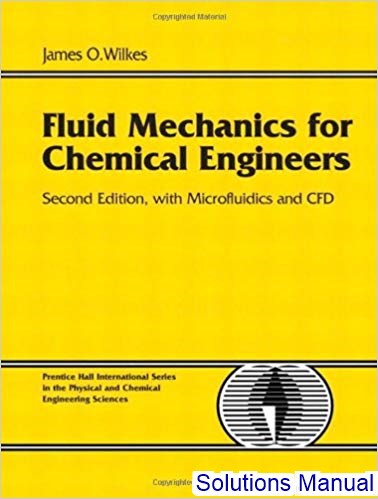
Product details:
- ISBN-10 : 0131482122
- ISBN-13 : 978-0131482128
- Author: Hassan Khalil (AuthorJames O. Wilkes (Author)
Fluid Mechanics for Chemical Engineers, Second Edition, with Microfluidics and CFD, systematically introduces fluid mechanics from the perspective of the chemical engineer who must understand actual physical behavior and solve real-world problems. Building on a first edition that earned Choice Magazine‘s Outstanding Academic Title award, this edition has been thoroughly updated to reflect the field’s latest advances.
This second edition contains extensive new coverage of both microfluidics and computational fluid dynamics, systematically demonstrating CFD through detailed examples using FlowLab and COMSOL Multiphysics. The chapter on turbulence has been extensively revised to address more complex and realistic challenges, including turbulent mixing and recirculating flows.
Table contents:
I. MACROSCOPIC FLUID MECHANICS.
1. Introduction to Fluid Mechanics.
1.1 Fluid Mechanics in Chemical Engineering
1.2 General Concepts of a Fluid
1.3 Stresses, Pressure, Velocity, and the Basic Laws
1.4 Physical Properties – Density, Viscosity, and Surface Tension
1.5 Units and Systems of Units
Example 1.1 – Units Conversion
Example 1.2 – Mass of Air in a Room
1.6 Hydrostatics
Example 1.3 – Pressure in an Oil Storage Tank
Example 1.4 – Multiple Fluid Hydrostatics
Example 1.5 – Pressure Variations in a Gas
Example 1.6 – Hydrostatic Force on a Curved Surface
Example 1.7 – Application of Archimedes?f Law
1.7 Pressure Change Caused by Rotation
Example 1.8 – Overflow from a Spinning Container
Problems for Chapter 1
2. Mass, Energy, and Momentum Balances.
2.1 General Conservation Laws
2.2 Mass Balances
Example 2.1 – Mass Balance for Tank Evacuation
2.3 Energy Balances
Example 2.2 – Pumping n-Pentane
2.4 Bernoulli’s Equation
2.5 Applications of Bernoulli?fs Equation
Example 2.3 – Tank Filling
2.6 Momentum Balances
Example 2.4 – Impinging Jet of Water
Example 2.5 – Velocity of Wave on Water
Example 2.6 – Flow Measurement by a Rotameter
2.7 Pressure, Velocity, and Flow Rate Measurement
Problems for Chapter
3. Fluid Friction in Pipes.
3.1 Introduction
3.2 Laminar Flow
Example 3.1 – Polymer Flow in a Pipeline
3.3 Models for Shear Stress
3.4 Piping and Pumping Problems
Example 3.2 – Unloading Oil from a Tanker
Specified Flow Rate and Diameter
Example 3.3 – Unloading Oil from a Tanker
Specified Diameter and Pressure Drop
Example 3.4 – Unloading Oil from a Tanker
Specified Flow Rate and Pressure Drop
Example 3.5 – Unloading Oil from a Tanker
Miscellaneous Additional Calculations
3.5 Flow in Noncircular Ducts
Example 3.6 – Flow in an Irrigation Ditch
3.6 Compressible Gas Flow in Pipelines
3.7 Compressible Flow in Nozzles
3.8 Complex Piping Systems
Example 3.7 – Solution of a Piping/Pumping Problem
Problems for Chapter 3
4. Flow in Chemical Engineering Equipment.
4.1 Introduction
4.2 Pumps and Compressors
Example 4.1 – Pumps in Series and Parallel
4.3 Drag Force on Solid Particles in Fluids
Example 4.2 – Manufacture of Lead Shot
4.4 Flow Through Packed Beds
Example 4.3 – Pressure Drop in a Packed-Bed Reactor
4.5 Filtration
4.6 Fluidization
4.7 Dynamics of a Bubble-Cap Distillation Column
4.8 Cyclone Separators
4.9 Sedimentation
4.10 Dimensional Analysis
Example 4.4 – Thickness of the Laminar Sublayer
Problems for Chapter 4
II. MICROSCOPIC FLUID MECHANICS.
5. Differential Equations of Fluid Mechanics.
5.1 Introduction to Vector Analysis
5.2 Vector Operations
Example 5.1 – The Gradient of a Scalar
Example 5.2 – The Divergence of a Vector
Example 5.3 – An Alternative to the Differential Element
Example 5.4 – The Curl of a Vector
Example 5.5 – The Laplacian of a Scalar
5.3 Other Coordinate Systems
5.4 The Convective Derivative
5.5 Differential Mass Balance
Example 5.6 – Physical Interpretation of the Net Rate of Mass Outflow
Example 5.7 – Alternative Derivation of the Continuity Equation
5.6 Differential Momentum Balances
5.7 Newtonian Stress Components in Cartesian Coordinates
Example 5.8 – Constant-Viscosity Momentum Balances in Terms of Velocity Gradients
Example 5.9 – Vector Form of Variable-Viscosity Momentum Balance
Problems for Chapter 5
6. Solution of Viscous-Flow Problems.
6.1 Introduction
6.2 Solution of the Equations of Motion in Rectangular Coordinates
Example 6.1 – Flow Between Parallel Plates
6.3 Alternative Solution Using a Shell Balance
Example 6.2 – Shell Balance for Flow Between Parallel Plates
Example 6.3 – Film Flow on a Moving Substrate
Example 6.4 – Transient Viscous Diffusion of Momentum (FEMLAB)
6.4 Poiseuille and Couette Flows in Polymer Processing
Example 6.5 – The Single-Screw Extruder
Example 6.6 – Flow Patterns in a Screw Extruder (FEMLAB)
6.5 Solution of the Equations of Motion in Cylindrical x Table of Contents Coordinates
Example 6.7 – Flow Through an Annular Die
Example 6.8 – Spinning a Polymeric Fiber
6.6 Solution of the Equations of Motion in Spherical Coordinates
Example 6.9 – Analysis of a Cone-and-Plate Rheometer
Problems for Chapter 6
7. Laplace’s Equation, Irrotational and Porous-Media Flows.
7.1 Introduction
7.2 Rotational and Irrotational Flows
Example 7.1 – Forced and Free Vortices
7.3 Steady Two-Dimensional Irrotational Flow
7.4 Physical Interpretation of the Stream Function
7.5 Examples of Planar Irrotational Flow
Example 7.2 – Stagnation Flow
Example 7.3 – Combination of a Uniform Stream and a Line Sink (C)
Example 7.4 – Flow Patterns in a Lake (FEMLAB)
7.6 Axially Symmetric Irrotational Flow
7.7 Uniform Streams and Point Sources
7.8 Doublets and Flow Past a Sphere
7.9 Single-Phase Flow in a Porous Medium
Example 7.5 – Underground Flow of Water
7.10 Two-Phase Flow in Porous Media
7.11 Wave Motion in Deep Water
Problems for Chapter 7
8. Boundary-Layer Aand Other Nearly Unidirectional Flows.
8.1 Introduction
8.2 Simplified Treatment of Laminar Flow Past a Flat Plate
Example 8.1 – Flow in an Air Intake
8.3 Simplification of the Equations of Motion
8.4 Blasius Solution for Boundary-Layer Flow
8.5 Turbulent Boundary Layers
Example 8.2 – Laminar and Turbulent Boundary Layers Compared
8.6 Dimensional Analysis of the Boundary-Layer Problem
8.7 Boundary-Layer Separation
Example 8.3 – Boundary-Layer Flow Between Parallel Plates (FEMLAB Library)
Example 8.4 – Entrance Region for Laminar Flow Between Flat Plates
8.8 The Lubrication Approximation
Example 8.5 – Flow in a Lubricated Bearing (FEMLAB)
8.9 Polymer Processing by Calendering
Example 8.6 – Pressure Distribution in a Calendered Sheet
8.10 Thin Films and Surface Tension
Problems for Chapter 8
9. Turbulent Flow.
9.1 Introduction
Example 9.1 – Numerical Illustration of a Reynolds Stress Term
9.2 Physical Interpretation of the Reynolds Stresse
9.3 Mixing-Length Theory
9.4 Determination of Eddy Kinematic Viscosity and Mixing Length
9.5 Velocity Profiles Based on Mixing Length Theory 486
Example 9.2 – Investigation of the von K?Larm?Lan Hypothesis
9.6 The Universal Velocity Profile for Smooth Pipes
9.7 Friction Factor in Terms of Reynolds Number for Smooth Pipes
Example 9.3 – Expression for the Mean Velocity
9.8 Thickness of the Laminar Sublayer
9.9 Velocity Profiles and Friction Factor for Rough Pipe
9.10 Blasius-Type Law and the Power-Law Velocity Profile
9.11 A Correlation for the Reynolds Stresses
9.12 Computation of Turbulence by the k/? Method
Example 9.4 – Flow Through an Orifice Plate (FEMLAB)
Example 9.5 – Turbulent Jet Flow (FEMLAB)
9.13 Analogies Between Momentum and Heat Transfer
Example 9.6 – Evaluation of the Momentum/Heat-Transfer Analogies
9.14 Turbulent Jets
Problems for Chapter 9
10. Bubble Motion, Two-Phase Flow, and Fluidization.
10.1 Introduction
10.2 Rise of Bubbles in Unconfined Liquids
Example 10.1 – Rise Velocity of Single Bubbles
10.3 Pressure Drop and Void Fraction in Horizontal Pipes
Example 10.2 – Two-Phase Flow in a Horizontal Pipe
10.4 Two-Phase Flow in Vertical Pipes
Example 10.3 – Limits of Bubble Flow
Example 10.4 – Performance of a Gas-Lift Pump
Example 10.5 – Two-Phase Flow in a Vertical Pipe
10.5 Flooding
10.6 Introduction to Fluidization
10.7 Bubble Mechanics
10.8 Bubbles in Aggregatively Fluidized Beds
Example 10.6 – Fluidized Bed with Reaction (C)
Problems for Chapter 10
11. Non-Newtonian Fluids.
11.1 Introduction
11.2 Classification of Non-Newtonian Fluids
11.3 Constitutive Equations for Inelastic Viscous Fluids
Example 11.1 – Pipe Flow of a Power-Law Fluid
Example 11.2 – Pipe Flow of a Bingham Plastic
Example 11.3 – Non-Newtonian Flow in a Die (FEMLAB Library)
11.4 Constitutive Equations for Viscoelastic Fluids
11.5 Response to Oscillatory Shear
11.6 Characterization of the Rheological Properties of Fluids
Example 11.4 – Proof of the Rabinowitsch Equation
Example 11.5 – Working Equation for a Coaxial Cylinder Rheometer: Newtonian Fluid
Problems for Chapter 11
12. Microfluidics and Electrokinetic Flow Effects.
12.1 Introduction
12.2 Physics of Microscale Fluid Mechanics
12.3 Pressure-driven Flow Through Microscale Tubes
Example 12.1 – Calculation of Reynolds Numbers
12.4 Mixing, Transport, and Dispersion
12.5 Species, Energy, and Charge Transport
12.6 The Electrical Double Layer and Electrokinetic Phenomena
Example 12.2 – Relative Magnitudes of Electroosmotic and Pressure-driven Flow
Example 12.3 – Electroosmotic Flow Around a Particle
Example 12.4 – Electroosmosis in a Microchannel (FEMLAB)
Example 12.5 – Electroosmotic Switching in a Branched Microchannel (FEMLAB)
12.7 Measuring the Zeta Potential
Example 12.6 – Magnitude of Typical Streaming Potentials
12.8 Electroviscosity
12.9 Particle and Macromolecule Motion in Microfluidic Channels
Example 12.7 – Gravitational and Magnetic Settling of Assay Beads
Problems for Chapter 12
13. An Introduction to Computational Fluid Dynamics and Flowlab.
13.1 Introduction and Motivation
13.2 Numerical Methods
13.3 Learning CFD by Using FlowLab
13.4 Practical CFD Examples
Example 13.1 – Developing Flow in a Pipe Entrance Region (FlowLab)
Example 13.2 – Pipe Flow Through a Sudden Expansion (FlowLab)
Example 13.3 – A Two-Dimensional Mixing Junction (FlowLab)
Example 13.4 – Flow Over a Cylinder (FlowLab)
References for Chapter 13
14. Femlab for Solving Fluid Mechanics Problems.
14.1 Introduction to FEMLAB
14.2 How to Run FEMLAB
Example 14.1 – Flow in a Porous Medium with an Obstruction (FEMLAB)
14.3 Draw Mode
14.4 Solution and Related Modes
14.5 Fluid Mechanics Problems Solvable by FEMLAB
Problems for Chapter 14
People also search:
fluid mechanics for chemical engineers
chemical engineering technician job description

